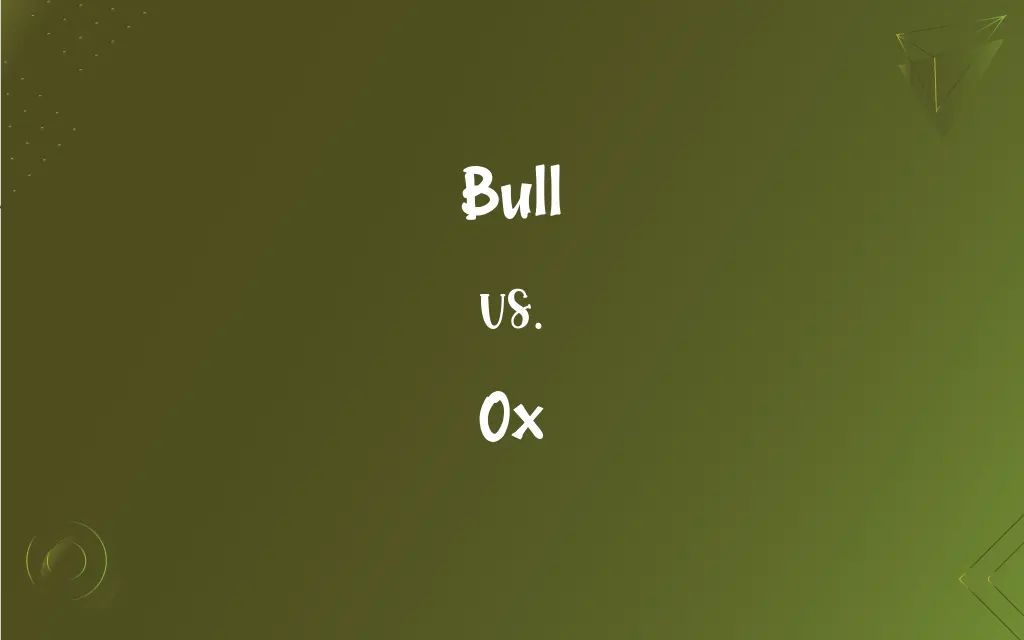Bull vs. Ox: What's the Difference?
Edited by Aimie Carlson || By Janet White || Updated on June 21, 2024
Bull is an uncastrated male bovine, often associated with strength and fertility. Ox is a castrated male bovine, typically used for labor and plowing.

Key Differences
A bull is an uncastrated male bovine, known for its vigor and used primarily for breeding purposes. An ox, by contrast, is a castrated male bovine, often trained for draft work such as plowing and pulling carts.
Bulls play a significant role in dairy and meat production industries due to their genetics and breeding capabilities. Oxen are valued for their strength and endurance, making them ideal for heavy labor in agricultural settings.
The physical build of a bull is generally more muscular and robust, suited for its role in breeding and sometimes in competitive events like bullfighting. Oxen, being castrated, develop a more docile temperament and a physique adapted to sustained physical labor.
In many cultures, bulls have symbolic meanings, often representing fertility and strength, and are featured in festivals and art. Oxen, historically significant in agriculture, symbolize hard work and patience in various cultural contexts.
The management and care of bulls require specific handling skills due to their aggressive nature and strength. Oxen, on the other hand, are trained for compliance and teamwork, often working in pairs or teams for tasks like plowing fields.
ADVERTISEMENT
Comparison Chart
Definition
Uncastrated male bovine
Castrated male bovine, used for labor
Primary Use
Breeding and genetic contribution
Draft and labor work, like plowing
Temperament
More aggressive and vigorous
Docile and trained for obedience
Physical Characteristics
Muscular and robust build
Strong, adapted for sustained labor
Cultural Significance
Symbolizes strength and fertility
Represents hard work and endurance
ADVERTISEMENT
Bull and Ox Definitions
Bull
A male bovine animal, especially one that is uncastrated.
The farmer used the bull for breeding his dairy cows.
Ox
Known for its endurance and capacity for labor.
The farmer relied on his ox for plowing the fields each spring.
Bull
Often featured in sports like bullfighting and rodeos.
The bull charged fiercely at the matador in the arena.
Ox
Represents patience and hard work in many cultures.
In folklore, the ox is often a symbol of diligence and persistence.
Bull
Requires skilled handling due to its aggressive nature.
Ranch hands exercised caution when moving the bull to a different field.
Ox
Essential in historical agricultural practices.
Before modern machinery, the ox was indispensable for farming.
Bull
Symbolizes strength and virility in various cultures.
In mythology, the bull is often associated with power and masculinity.
Ox
A castrated male bovine, typically trained for draft work.
The ox pulled the heavy cart with ease, thanks to its strength.
Bull
Key to the livestock industry for genetic contribution.
The prize-winning bull was highly valued for its superior genetics.
Ox
Often works in pairs for tasks like hauling and plowing.
The pair of oxen worked in unison to pull the plow.
Bull
An adult male bovine mammal.
Ox
An adult castrated bull of the genus Bos, especially B. taurus, used chiefly as a draft animal.
Bull
The uncastrated adult male of domestic cattle.
Ox
A bovine mammal, especially one that has been domesticated.
Ox
An adult castrated male of cattle (B. taurus), especially when used as a beast of burden.
Ox
Any bovine animal (genus Bos). A neat, a beef.
Ox
Abbreviation of oxygen
Ox
The male of bovine quadrupeds, especially the domestic animal when castrated and grown to its full size, or nearly so. The word is also applied, as a general name, to any species of bovine animals, male and female.
All sheep and oxen, yea, and the beasts of the field.
Ox
An adult castrated bull of the genus Bos; especially Bos taurus
Ox
Any of various wild bovines especially of the genera Bos or closely related Bibos
FAQs
What kind of temperament do oxen have?
Oxen are generally docile and compliant, making them good for labor.
Are oxen still used for labor today?
Yes, in many parts of the world, oxen are still used for agricultural labor.
How do bulls contribute to dairy farming?
Bulls provide genetic material for breeding dairy cows.
What is the primary difference between a bull and an ox?
A bull is uncastrated, used for breeding; an ox is castrated, used for labor.
Can a bull be trained to do work like an ox?
It's rare, as bulls are generally more aggressive and less suited for labor.
How are oxen trained for labor?
Oxen are trained through consistent and gentle handling from a young age.
Do bulls play a role in any cultural practices?
Yes, bulls are featured in cultural events like bullfighting and rodeos.
Are there specific breeds of cattle used as bulls?
Certain breeds like Angus and Hereford are popular for their bull qualities.
What is the lifespan of a bull in captivity?
Bulls can live up to 15-20 years in captivity with proper care.
Do bulls need special diets?
Bulls require a nutritious diet to maintain their health and vigor.
How long can an ox work in agricultural settings?
With proper care, an ox can work for many years in farming tasks.
Is the ox still relevant in modern farming?
In regions with limited access to machinery, oxen remain relevant.
What are the physical characteristics of an ox?
Oxen are strong and sturdy, built for endurance and heavy labor.
What kind of shelter do oxen need?
Oxen require basic shelter that protects them from extreme weather.
Can bulls be aggressive towards humans?
Yes, bulls can be unpredictable and aggressive, requiring cautious handling.
How do farmers manage the aggressive nature of bulls?
Through secure enclosures and experienced handling.
Do bulls have a role in religious ceremonies?
In some cultures, bulls are integral to certain religious practices.
Are oxen faster than bulls?
No, oxen are generally slower, prioritizing strength over speed.
Are there specific breeds more suited to be oxen?
Breeds like the Holstein and Brahman are often used as oxen due to their size and strength.
Can oxen adapt to different types of work?
Yes, oxen can be trained for various tasks like hauling, plowing, and carting.
About Author
Written by
Janet WhiteJanet White has been an esteemed writer and blogger for Difference Wiki. Holding a Master's degree in Science and Medical Journalism from the prestigious Boston University, she has consistently demonstrated her expertise and passion for her field. When she's not immersed in her work, Janet relishes her time exercising, delving into a good book, and cherishing moments with friends and family.
Edited by
Aimie CarlsonAimie Carlson, holding a master's degree in English literature, is a fervent English language enthusiast. She lends her writing talents to Difference Wiki, a prominent website that specializes in comparisons, offering readers insightful analyses that both captivate and inform.































































